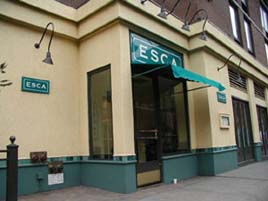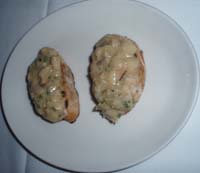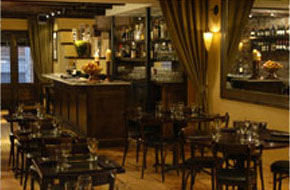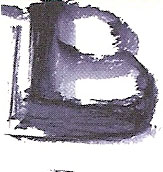

It’s hard to know when you can trust Frank Bruni. He seems to give a one-star premium just because a restaurant is Italian. And he seems to give a one-star premium wherever Mario Batali is involved. In just three years on the job, he has awarded nine stars to Mario Batali’s restaurants, a remarkable total.
So when Frank Bruni promoted Esca to three stars (his predecessor had awarded two), I had to wonder: was it really that good? Or was Frank just up to his usual mischief? Luckily, there was a parade of almost exclusively favorable comments on the eGullet boards, which persuaded me that I really must try Esca.

Bruschetta to start
It wasn’t easy. Esca fills up in a hurry. Several times I tried to reserve, only to find that 10:00 p.m. was the only time slot available. And no, I wasn’t that desperate to eat there. Last night, finally, I had an 8:00 p.m. slot. But even in late August, Esca was packed.
I agree with Frank Bruni about one more thing. The key to Esca’s success is that its chef and co-owner, David Pasternack, hasn’t over-extended himself. According to Bruni, whenever he’s called the restaurant for an interview, Pasternack is nearly always there. These days, when a restaurant is as successful as Esca, the chef starts to become an industry. Pasternack has dallied a little, but Esca remains his home.
Esca—the name means bait—introduced crudo, the Italian version of raw fish appetizers, to New York. Bruni, at least, credits Pasternack with the innovation. It was sufficiently obscure that William Grimes, in his 2000 review, had to explain what it meant. Nowadays, it’s all over town.
The menu’s crudo selections are followed by standard appetizers, pastas, and fish entrées. A solitary veal dish is the lone concession to the meat-lover. There’s no obligatory strip steak or roast chicken for the patron who was dragged along, but really doesn’t like seafood. If you can’t or won’t eat sea creatures, there’s probably no point in visiting Esca.
 According to the website, the menu changes every two weeks. The menu currently shown there is quite a bit different from the one we saw—and also noticeably less expensive. I don’t know if it’s a very old menu, or if the prices were jacked up after Bruni awarded the third star. Nowadays, I think a restaurant in Esca’s class ought to have a reasonably current menu on its website.
According to the website, the menu changes every two weeks. The menu currently shown there is quite a bit different from the one we saw—and also noticeably less expensive. I don’t know if it’s a very old menu, or if the prices were jacked up after Bruni awarded the third star. Nowadays, I think a restaurant in Esca’s class ought to have a reasonably current menu on its website.
While we pondered our order, a sommelier came over to offer assistance. The wine list is of medium length, and nearly all Italian. There’s an ample number of good options below $60. I asked for a red wine under that figure that would go well with the entrées we were considering. He instantly offered a fine suggestion at $54.
After pouring the first taste, he took the bottle away and put it on a serving table out of sight. Only a few restaurants in New York do this, and I find it a bit annoying. I don’t need someone to pour my wine for me, and I don’t like having to look around to signal for another pour. My request to have the bottle put back under my control was granted without complaint.


Orange Marlin (left); Verdura Mista (right)
I started with one of the crudo selections, Orange Marlin ($16). It was perfectly seasoned—just delightful. By the way, the restaurant offers a two-flight crudo tasting for $30 per person, and I’ve made a mental note to try one of these days. My girlfriend started with a salad of Verdura Mista ($16), and the kitchen did a superb job with this deceptively simple dish.


Squid ink pasta with cuttlefish and garlic (left); Whole orata (right)
There are about a dozen pasta dishes, orderable as a main course or as a mid-course to split. We shared the Squid ink pasta with cuttlefish and garlic ($24). We were again impressed, as the contrasting flavors seemed to be so perfectly judged.
The menu offers several whole fish, in addition to a larger number of composed dishes. I ordered the Orata ($33), a kind of sea bream, served whole. The preparation was straightforward, but the flesh was tender, sweet, and just slightly lemony. It came off the bone without difficulty. My girlfriend was less impressed with Merluzzo ($34), a kind of cod. She found it a bit dull, and even had to ask for salt to make it more lively—and that is not something she often does.

Biscotti
At Esca, both the space and the service occupy that middle ground between casual and formal that Mario Batali has mastered at his flagship restaurant, Babbo. There are white tablecloths, and an alert service brigade stays on top of things, but you could show up in jeans, and not feel out-of-place.
On the whole, we left Esca quite impressed. Three courses apiece, plus a $54 bottle of wine still came to under $200 before tip, and in this town it’s difficult to get such a good a meal at that price.
Esca (402 W. 43rd Street at Ninth Avenue, Hell’s Kitchen)
Food: ***
Service: ***
Ambiance: **
Overall: ***
 Wednesday, September 12, 2007 at 11:48AM
Wednesday, September 12, 2007 at 11:48AM  Bar Stuzzichini in
Bar Stuzzichini in  BruniBetting
BruniBetting 






















